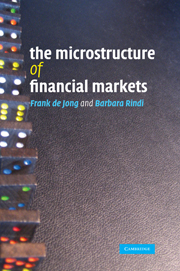Book contents
- Frontmatter
- Contents
- List of figures
- List of tables
- Preface
- Introduction
- 1 Institutions and market structure
- 2 Financial market equilibrium
- 3 Batch markets with strategic informed traders
- 4 Dealer markets: information-based models
- 5 Inventory models
- 6 Empirical models of market microstructure
- 7 Liquidity and asset pricing
- 8 Models of the limit order book
- 9 Price discovery
- 10 Policy issues in financial market structure
- Index
10 - Policy issues in financial market structure
Published online by Cambridge University Press: 05 June 2012
- Frontmatter
- Contents
- List of figures
- List of tables
- Preface
- Introduction
- 1 Institutions and market structure
- 2 Financial market equilibrium
- 3 Batch markets with strategic informed traders
- 4 Dealer markets: information-based models
- 5 Inventory models
- 6 Empirical models of market microstructure
- 7 Liquidity and asset pricing
- 8 Models of the limit order book
- 9 Price discovery
- 10 Policy issues in financial market structure
- Index
Summary
In the Introduction we observed that microstructure models are theoretical tools useful both in discussing market design and regulation and in explaining the empirical findings on market price dynamics. In this chapter we consider the issue of transparency, using the models of Kyle and of Grossman and Stiglitz to evaluate the effects of different types of information disclosure on market quality and traders' welfare. Further, we show how Kyle's model can be usefully extended to explain the intraday pattern of volume. Finally we show how liquidity can be crucial to understanding the forces that work for consolidation and for fragmentation.
Transparency
In this section we return to the transparency of financial markets, which was introduced in Chapter 1. The degree of transparency is relevant because it influences traders' strategies, hence the pricing process. However, given the great variety of aspects, assessing the effects of pre-trade transparency on market quality is complicated, so it is not surprising that the results offered by the literature differ significantly depending on the market structure considered and the type of information revealed. If one models transparency as the increased visibility of the liquidity suppliers' order flows, the effects of pre-trade transparency on market quality will show the benefits of the reduction in adverse selection costs for liquidity and uninformed traders' welfare. Clearly, when liquidity suppliers can screen informed and uninformed traders, they can also offer liquidity on better terms to the uninformed.
- Type
- Chapter
- Information
- The Microstructure of Financial Markets , pp. 180 - 196Publisher: Cambridge University PressPrint publication year: 2009

